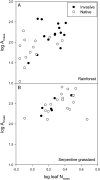The physiology of invasive plants in low-resource environments
- PMID: 27293610
- PMCID: PMC4806624
- DOI: 10.1093/conphys/cot026
The physiology of invasive plants in low-resource environments
Abstract
While invasive plant species primarily occur in disturbed, high-resource environments, many species have invaded ecosystems characterized by low nutrient, water, and light availability. Species adapted to low-resource systems often display traits associated with resource conservation, such as slow growth, high tissue longevity, and resource-use efficiency. This contrasts with our general understanding of invasive species physiology derived primarily from studies in high-resource environments. These studies suggest that invasive species succeed through high resource acquisition. This review examines physiological and morphological traits of native and invasive species in low-resource environments. Existing data support the idea that species invading low-resource environments possess traits associated with resource acquisition, resource conservation or both. Disturbance and climate change are affecting resource availability in many ecosystems, and understanding physiological differences between native and invasive species may suggest ways to restore invaded ecosystems.
Keywords: Invasion biology; leaf economics spectrum; resource acquisition; resource conservation; restoration ecology.
Figures




Similar articles
-
Resource-use efficiency and plant invasion in low-resource systems.Nature. 2007 Apr 26;446(7139):1079-81. doi: 10.1038/nature05719. Nature. 2007. PMID: 17460672
-
Plant functional traits of dominant native and invasive species in mediterranean-climate ecosystems.Ecology. 2016 Jan;97(1):75-83. doi: 10.1890/15-0974.1. Ecology. 2016. PMID: 27008777
-
Soil fertility and disturbance interact to drive contrasting responses of co-occurring native and nonnative species.Ecology. 2016 Feb;97(2):515-29. doi: 10.1890/15-0298.1. Ecology. 2016. PMID: 27145625
-
Interactions between resource availability and enemy release in plant invasion.Ecol Lett. 2006 Jul;9(7):887-95. doi: 10.1111/j.1461-0248.2006.00934.x. Ecol Lett. 2006. PMID: 16796578 Review.
-
The ecology, distribution, conservation and management of large old trees.Biol Rev Camb Philos Soc. 2017 Aug;92(3):1434-1458. doi: 10.1111/brv.12290. Epub 2016 Jul 7. Biol Rev Camb Philos Soc. 2017. PMID: 27383287 Review.
Cited by
-
Habitat properties and plant traits interact as drivers of non-native plant species' seed production at the local scale.Ecol Evol. 2018 Apr 2;8(8):4209-4223. doi: 10.1002/ece3.3940. eCollection 2018 Apr. Ecol Evol. 2018. PMID: 29721292 Free PMC article.
-
Increased ploidy of Butomus umbellatus in introduced populations is not associated with higher phenotypic plasticity to N and P.AoB Plants. 2021 Jul 20;13(4):plab045. doi: 10.1093/aobpla/plab045. eCollection 2021 Aug. AoB Plants. 2021. PMID: 34394906 Free PMC article.
-
Effect of drought and nutrient availability on invaded plant communities in a semi-arid ecosystem.Ecol Evol. 2022 Sep 9;12(9):e9296. doi: 10.1002/ece3.9296. eCollection 2022 Sep. Ecol Evol. 2022. PMID: 36177142 Free PMC article.
-
Conservation physiology today and tomorrow.Conserv Physiol. 2014 Jan 7;2(1):cot033. doi: 10.1093/conphys/cot033. eCollection 2014. Conserv Physiol. 2014. PMID: 27293617 Free PMC article. No abstract available.
-
The Invasion of Coastal Areas in South China by Ipomoea cairica May Be Accelerated by the Ecotype Being More Locally Adapted to Salt Stress.PLoS One. 2016 Feb 11;11(2):e0149262. doi: 10.1371/journal.pone.0149262. eCollection 2016. PLoS One. 2016. PMID: 26867222 Free PMC article.
References
-
- Aanderud ZT, Bledsoe CS. (2009) Preferences for 15N-ammonium, 15N-nitrate, and 15N-glycine differ among dominant exotic and subordinate native grasses from a California oak woodland. Environ Exp Bot 65: 205–209.
-
- Aarssen LW. (1983) Ecological combining ability and competitive combining ability in plants: toward a general evolutionary theory of coexistence in systems of competition. Am Nat 122: 707–731.
-
- Ackerly DD, Bazzaz FA. (1995) Leaf dynamics, self-shading and carbon gain in seedlings of a tropical pioneer tree. Oecologia 101: 289–298. - PubMed
-
- Alpert P, Bone E, Holzapfel C. (2000) Invasiveness, invasibility and the role of environmental stress in the spread of non-native plants. Perspect Plant Ecol Evol Syst 3: 52–66.
-
- Angert AL, Huxman TE, Barron-Gafford GA, Gerst KL, Venable DL. (2007) Linking growth strategies to long-term population dynamics in a guild of desert annuals. J Ecol 95: 321–331.
Publication types
LinkOut - more resources
Full Text Sources
Other Literature Sources

